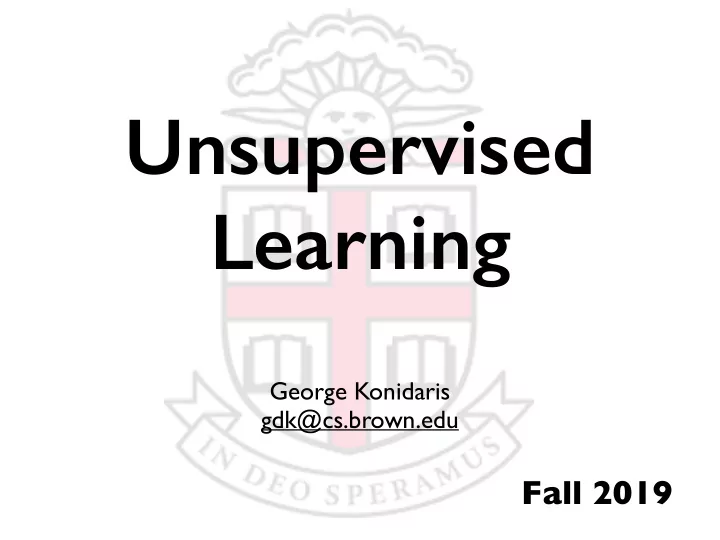

Unsupervised Learning George Konidaris gdk@cs.brown.edu Fall 2019
Machine Learning Subfield of AI concerned with learning from data . Broadly, using: • Experience • To Improve Performance • On Some Task (Tom Mitchell, 1997)
Unsupervised Learning Input: inputs X = {x 1 , …, x n } Try to understand the structure of the data. E.g., how many types of cars? How can they vary?
Clustering One particular type of unsupervised learning: • Split the data into discrete clusters. • Assign new data points to each cluster. • Clusters can be thought of as types . Formal definition Given: • Data points X = {x 1 , …, x n }. Find: • Number of clusters k • Assignment function f(x) = {1, …, k}
Clustering
k-Means One approach: • Pick k • Place k points (“means”) in the data • Assign new point to i th cluster if nearest to i th “mean”.
k-Means
k-Means Major question: • Where to put the “means”? Very simple algorithm: • Place k “means” at random. { µ 1 , ..., µ k } • Assign all points in the data to each “mean” f ( x j ) = i such that d ( x j , µ i ) d ( x j , µ l ) 8 l 6 = i • Move each “mean” to mean of assigned data. x v X µ i = | C i | v ∈ C i
k-Means
k-Means
k-Means
k-Means
k-Means Remaining questions … How to choose k ? What about bad initializations? How to measure distance? Broadly: • Use a quality metric. • Loop through k . • Random restart initial position. • Use distance metric D .
Density Estimation Clustering: can answer which cluster, but not does this belong ?
Density Estimation Estimate the distribution the data is drawn from . This allows us to evaluate the probability that a new point is drawn from the same distribution as the old data. Formal definition Given: • Data points X = {x 1 , …, x n }, Find: • PDF P(X)
GMM Simple approach: • Model the data as a mixture of Gaussians. Each Gaussian has its own mean and variance. Each has its own weight (sum to 1). Weighted sum of Gaussians still a PDF.
GMM
GMM Algorithm - broadly as before: • Place k “means” at random. { µ 1 , ..., µ k } • Set variances to be high. • Assign all points to highest probability distribution. C i = { x v | N ( x v | µ i , σ 2 i ) > N ( x v | µ j , σ 2 j ) , ∀ j } • Set mean, variance, weights to match assigned data. | C i | x v X σ 2 w i = µ i = i = variance( C i ) P j | C j | | C i | v ∈ C i
GMM
GMM
GMM
GMM Major issue: • How to decide between two GMMs? • How to choose k ? General statistical question: model selection. Several good answers for this. Simple example: Bayesian information criterion (BIC). Trades off model complexity (k) with fit (likelihood). − 2 log L + k log n # data # parameters points likelihood in model
Nonparametric Density Estimation Parametric: • Define a parametrized model (e.g., a Gaussian) • Fit parameters • Done! Key assumptions : • Data is distributed according to the parametrized form. • We know which parametrized form in advance. What is the shape of the distribution over images representing flowers?
Nonparametric Density Estimation Nonparametric alternative: • Avoid fixed parametrized form. • Compute density estimate directly from the data. Kernel density estimator: n ✓ x i − x ◆ PDF ( x ) = 1 X D nb b i =1 where: • D is a special kind of distance metric called a kernel. • Falls away from zero, integrates to one. • b is bandwidth: controls how fast kernel falls away.
Nonparametric Density Estimation n ✓ x i − x ◆ PDF ( x ) = 1 X D nb b i =1 Kernel: • Lots of choices, Gaussian often works in practice. Bandwidth: • High: distant points have higher “contribution” to sum. • Low: distant points have lower.
Nonparametric Density Estimation (wikipedia)
Nonparametric Density Estimator
Dimensionality Reduction X = {x 1 , …, x n }, each x i has m dimensions: x i = [x 1 , …, x m ] . If m is high, data can be hard to deal with. • High-dimensional decision boundary. • Need more data. • But data is often not really high-dimensional. Dimensionality reduction: • Reduce or compress the data • Try not to lose too much! • Find intrinsic dimensionality
Dimensionality Reduction For example, imagine if x 1 and x 2 are meaningful features, and x 3 … x m are random noise. What happens to k-nearest neighbors? What happens to a decision tree? What happens to the perceptron algorithm? What happens if you want to do clustering?
Dimensionality Reduction Often can be phrased as a projection: f : X → X 0 where: • | X 0 | << | X | • our goal: retain as much sample variance as possible. Variance captures what varies within the data .
PCA Principle Components Analysis. Project data into a new space: • Dimensions are linearly uncorrelated. • We have a measure of importance for each dimension.
PCA
Recommend
More recommend